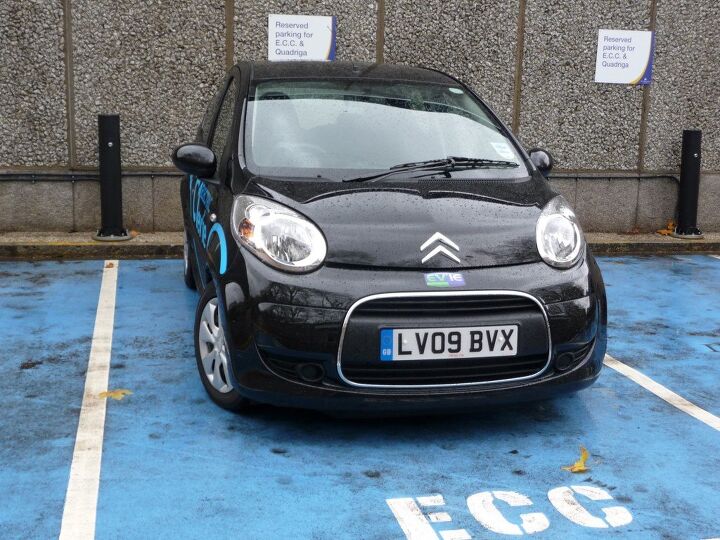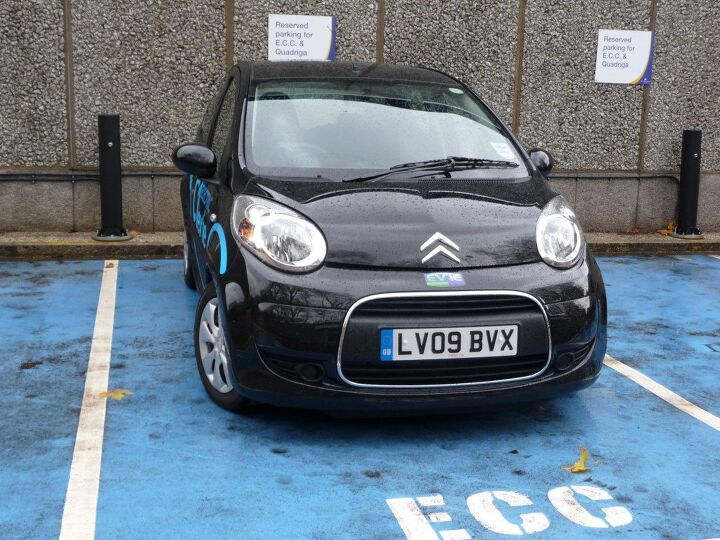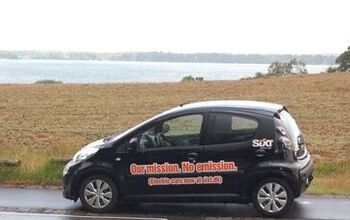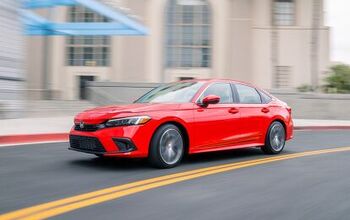Review: Citroen C1 ev'ie

The Toyota Aygo, which is the (in-all-but-styling) identical twin of the Citroen C1, is a fine little car, and when I tested it in 2007, I found most everything about it likeable. Packaging, finish, styling, handling, pleasure of driving: the Aygo/C1 turned out to be a thoroughly modern and enjoyable car for a bare-bones price. Only the ride struck me as a bit harsh. I certainly didn’t complain about the revvy, pleasant-sounding and parsimonious engine either, so you might be surprised to hear that I like the electrified version of the C1 just as well. Or, with qualifications, even more. What the heck do I mean? Please bear with me, and I’ll tell you.
The U.K. – based Electric Car Company (ECC) was founded by a guy who made his fortune with electronic traffic management systems. Intrigued with the idea of a zero-emission car, he tried some out, and thought he could easily do a whole lot better. The ev’ie, thus, does not look like something some blokes in a garage screw together in their spare evenings. What ECC does is buy C1s, remove the engine and gas tank, and add batteries, motor, heater, and an engine-management system. Open the hood and you see batteries and various electronic gizmos mostly bedecked by plastic casing. It looks clean and assembly-line standard, and not at all improvised. A second set of Lithium batteries is where the gas tank used to be. The trunk, in contrast to the sodium-batteried E-Twingo, is undiminished. So the ev’ie is what the stock C1 is what the Aygo is what the Peugeot 107 is: a lightweight, almost Smart-short car that can transport four and a tiny bit of luggage. (Don’t get me wrong: this is no limo, but it certainly beats an original VW Beetle for space. And the room in front is perfectly adequate in all dimensions unless you’re a widebody).
Incidentally, the ev’ie’s interior has optional plastichrome highlights I have never seen on a C1 outside of the U.K. I don’t like it, but that may just be a German complaining about British taste.
So what’s it like to drive? Well, you buckle up, turn the key, watch the battery indicator lights (where the tachometer is on regular C1s) fire up, and put the car in “forward” gear (there’s also a neutral and rear gear, but no clutch). When you disengage the hand brake and press on the gas pedal, you hear a soft zingy electric sound well-known to those who travel on streetcars or high-speed trains. As you start moving, the zingy sound disappears and then… nothing. Basically no motor sound at all. It’s eerie and somewhat different from other EVs I have driven.
I drove the ev’ie through London in Kensington and Westminster, and with the help of ECC’s Richard Turnbull who knows where traffic cameras are located, was able to take it up to semi-highway speed. Here’s my verdict. Not fast, but acceptable acceleration, and zero drama: overall very pleasant.
Don’t discount the zero drama thing. Within minutes, you stop missing the vibration, the non-linear acceleration, the various noise levels, of internal-combustion driving. You do suffer from a kind of disorientation from a while, not quite knowing how fast you’re going, which in combination with left-hand-side driving (I don’t often drive in the U.K), forced me to concentrate. But the overall effect is relaxing. No wonder: a linear speed-to-noise relationship is something we know from all kinds of propulsion, except airflight and ICE motoring.
As in the stock C1, the steering is fine, with the right level of directness and assistance. If I had to qualify a difference, I’d say the ev’ie feels more solid. The regenerative braking system, which charges the batteries when you lift off the gas pedal or brake, is smooth and capable.
So all is well on the electric front? Not quite. With a top speed of 60 mph and a reported distinct wheeziness on higher-speed hills, this is no more than an urban/suburban car. The electric-utility boss in Zurich I wrote about: he’d be less than satisfied with 41HP pushing 890KG, which is a power-to-weight ratio of a 1960s Beetle. (You do have all the torque the motor can muster – 112lb ft– from standstill, though). And the range is only 60 miles, so forget vacationing with ev’ie.
But nevertheless: it’s the only really good-to-drive, affordable, crashworthy, zero-emission car on the market today. Which is sure saying something! But does it make any financial sense at all? Electric cars are famously expensive. Well, prime your inner nerd and allow me to do the data thing, please.
The ev’ie costs about £18,500, which is a whopping £8,000 more than a stock C1. A utility charges 90 pence for around 60 miles worth of electricity. Assuming a yearly mileage of 10,000 miles per year based on 50 miles/day and 200 commuting days, the ev’ie would thus require electricity costing around £144 per year. Fuel costs, in contrast, would amount to £1,144, if one assumed a cost of £1.1 per liter and a fuel consumption of 6.5L/100km (equivalent to 36.2 MPG US). The difference, according to this calculation, would be one thousand Pounds ($1,645) per year. At current prices, therefore, a commuter would need over seven years to amortize the cost of the ev’ie in comparison to a stock C1. Even at these formidable European fuel price levels. Bummer!
But wait. In the U.K., an electric car costs less in insurance, and zero in road tax too. Both can easily add up to £200 per year. But that’s only the beginning. In London, and soon in many other U.K. towns, there is a congestion charge for gasoline cars – but none for electrics. Which saves you £1,600 based on a commute to London 200 days a year. And parking, depending on which community you stay in, is much cheaper for an EV. In Westminster, for example, it’s £200 per year for the ev’ie, as opposed to £4,000 for a normal car. Not enough? The U.K government plans a £5k purchasing incentive for electric cars starting in 2011. But even at the present time, incentives in an electric-
friendly place like the U.K easily add up to a cost advantage of £2k to £7k per year, so you can recoup the cost of this car within 2-3 years. At which point it becomes almost compelling, even without thinking about global warming, emissions, terrorists and foreign oil despots, or rising fuel costs. Or without looking at the trend lines: that petroleum-based transport is fated to become more expensive year by year, while the cost of batteries is set to sink.
Of course, the ev’ie only makes sense because the U.K. government has determined that the negative externalities (the “costs to society”) of electric cars are much lower than those of a petroleum-engined one, and has changed its charge regime accordingly. Other governments are following suit, like it or not.
Bottom line: the first reasonable electric car is a Citroen that some fellows in Hertfordshire convert to a feasible proposition, to a pleasant and safely-driving vehicle, in 24 man-hours. This sure isn’t a car for everybody; its range and speed limitations means it excels as a commuter but not as anything else. But it does throws mud in the face of most of the major car makers.

More by Martin Schwoerer
Latest Car Reviews
Read moreLatest Product Reviews
Read moreRecent Comments
- Bkojote Allright, actual person who knows trucks here, the article gets it a bit wrong.First off, the Maverick is not at all comparable to a Tacoma just because they're both Hybrids. Or lemme be blunt, the butch-est non-hybrid Maverick Tremor is suitable for 2/10 difficulty trails, a Trailhunter is for about 5/10 or maybe 6/10, just about the upper end of any stock vehicle you're buying from the factory. Aside from a Sasquatch Bronco or Rubicon Jeep Wrangler you're looking at something you're towing back if you want more capability (or perhaps something you /wish/ you were towing back.)Now, where the real world difference should play out is on the trail, where a lot of low speed crawling usually saps efficiency, especially when loaded to the gills. Real world MPG from a 4Runner is about 12-13mpg, So if this loaded-with-overlander-catalog Trailhunter is still pulling in the 20's - or even 18-19, that's a massive improvement.
- Lou_BC "That’s expensive for a midsize pickup" All of the "offroad" midsize trucks fall in that 65k USD range. The ZR2 is probably the cheapest ( without Bison option).
- Lou_BC There are a few in my town. They come out on sunny days. I'd rather spend $29k on a square body Chevy
- Lou_BC I had a 2010 Ford F150 and 2010 Toyota Sienna. The F150 went through 3 sets of brakes and Sienna 2 sets. Similar mileage and 10 year span.4 sets tires on F150. Truck needed a set of rear shocks and front axle seals. The solenoid in the T-case was replaced under warranty. I replaced a "blend door motor" on heater. Sienna needed a water pump and heater blower both on warranty. One TSB then recall on spare tire cable. Has a limp mode due to an engine sensor failure. At 11 years old I had to replace clutch pack in rear diff F150. My ZR2 diesel at 55,000 km. Needs new tires. Duratrac's worn and chewed up. Needed front end alignment (1st time ever on any truck I've owned).Rear brakes worn out. Left pads were to metal. Chevy rear brakes don't like offroad. Weird "inside out" dents in a few spots rear fenders. Typically GM can't really build an offroad truck issue. They won't warranty. Has fender-well liners. Tore off one rear shock protector. Was cheaper to order from GM warehouse through parts supplier than through Chevy dealer. Lots of squeaks and rattles. Infotainment has crashed a few times. Seat heater modual was on recall. One of those post sale retrofit.Local dealer is horrific. If my son can't service or repair it, I'll drive 120 km to the next town. 1st and last Chevy. Love the drivetrain and suspension. Fit and finish mediocre. Dealer sucks.
- MaintenanceCosts You expect everything on Amazon and eBay to be fake, but it's a shame to see fake stuff on Summit Racing. Glad they pulled it.















































Comments
Join the conversation
Its'-its been almost 15 months since this thread was written; Does anyone have any knowlege of how successful were sales of the the C1? and the EEC C1? What kind of people in which countries buy - and drive - these Citroens? Anyone know anything? 6 - 4 -2011
I have a C1 electric car i have disconnected the battery to have some repair carried out to the gear box of the car. i now connected back the batteries but the car would not go, I have a fully charged battery, it is showing 95% it would only move for about 3 meters forward and 3 meters backwards, then comes up with the word stall. does anyone knows if i have to carry out any resetting procedures or can anyone help me to resolve this problem? thank you -funnfaz